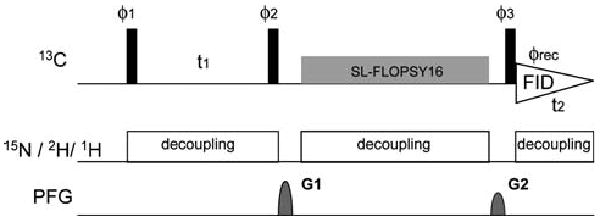Fig. 1.

Pulse scheme of the CACA-TOCSY experiment optimized for uniformly 2H15N- and alternate 13C–12C -labeled samples. Black bars indicate non-selective π/2 pulses. FLOPSY-16 was applied for spin locking (3.5 kHz). The phase cycle employed was ϕ1 = (x, −x), ϕ2 = (x, x, −x, −x), ϕ3 = (x, x, x, x, −x, −x, −x, −x), and ϕrec = (x, −x, −x, x, −x, x, x, −x). Phase sensitive spectra in the indirect dimension are obtained by incrementing the phases ϕ1 in a States-TPPI manner (Marion et al. 1989). The recycling delay is optimized based on the estimated longitudinal relaxation time (4.5 s was used in here). The two sine-shaped pulsed field gradients were applied along the z-axis for 1.0 ms with maximum intensities of G1 = 40 G/cm and G2 = 35 G/cm. Broad-band decoupling was achieved by using WALTZ16 (Shaka et al. 1983) for proton and deuterium (3.1 and 1 kHz, respectively) and GARP (Shaka et al. 1985) for nitrogen (1.5 kHz)
